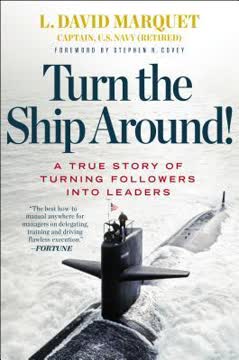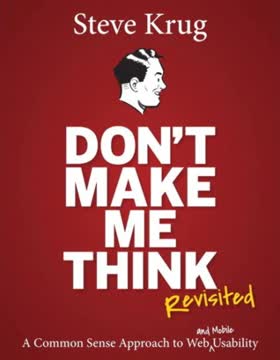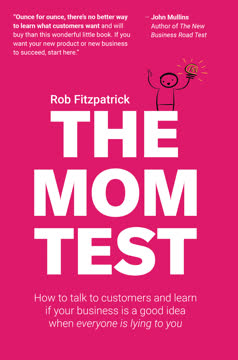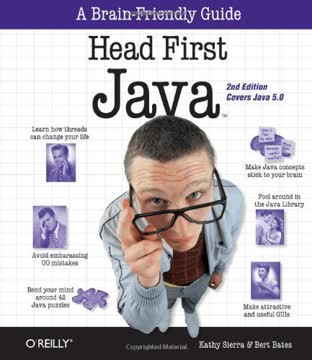Key Takeaways
1. Create Badass Users, Not Just Badass Products
"They don't want to be badass at our thing. They want to be badass at what they do with it."
Shift your focus. Instead of solely improving your product, concentrate on making your users better at using it. This approach leads to more sustained success and organic growth through word-of-mouth recommendations.
User success drives product success. When users become highly skilled and achieve impressive results with your product, they naturally become its best advocates. This creates a positive feedback loop where user excellence fuels product adoption and further improvement.
Key benefits of focusing on user expertise:
- Increased user satisfaction and loyalty
- More genuine word-of-mouth marketing
- Higher perceived value of your product
- Differentiation in crowded markets
2. Help Users Progress Through the Suck Zone
"The single biggest problem for most people on most expertise curves is having too many things on the B board"
Acknowledge the struggle. Recognize that learning new skills often involves a difficult "Suck Zone" where users feel incompetent and frustrated. By openly addressing this phase, you can help users persist through it.
Provide targeted support. Design your onboarding and early user experience to minimize time spent in the Suck Zone. Break down complex skills into smaller, manageable sub-skills that users can master quickly.
Strategies to help users through the Suck Zone:
- Set realistic expectations about initial difficulties
- Offer encouragement and reassurance that struggles are normal
- Provide clear, achievable milestones to mark progress
- Celebrate small wins to boost motivation
3. Implement Deliberate Practice for Skill Development
"Practice does not make perfect. In the science of expertise, the form of explicit practice that's known to work effectively is referred to as Deliberate Practice."
Focus on quality practice. Deliberate Practice involves breaking down skills into small, specific components and practicing them intensively with immediate feedback. This approach is far more effective than simply repeating tasks without a structured plan.
Design practice exercises. Create or recommend exercises that allow users to achieve 95% reliability in a specific sub-skill within 1-3 practice sessions of 45-90 minutes each. If this goal isn't achievable, further break down the skill or adjust the performance criteria.
Key elements of Deliberate Practice:
- Specific, well-defined tasks
- Appropriate difficulty level (challenging but achievable)
- Immediate, informative feedback
- Opportunities for repetition and refinement
4. Leverage Perceptual Exposure for Unconscious Learning
"Simply being exposed to examples of expertise doesn't necessarily build perceptual knowledge unless the exposure meets specific criteria."
Harness unconscious learning. Perceptual Exposure allows users to develop deep pattern recognition and intuition without conscious effort. This can dramatically accelerate skill acquisition in complex domains.
Design effective exposure exercises. Create experiences that expose users to a high quantity of high-quality examples within a compressed timeframe. This helps their brains identify underlying patterns and structures.
Guidelines for Perceptual Exposure:
- Use a large set of diverse, high-quality examples
- Provide immediate feedback after exposure
- Focus on examples of excellence, minimizing exposure to poor examples
- Allow for repeated exposure over time
5. Design a Clear Performance Path Map
"An ideal Performance Path Map: Clear steps of progression from beginner to badass."
Provide a roadmap to expertise. Create a clear, step-by-step progression that shows users how to advance from beginner to expert level. This gives them confidence in the learning process and motivates continued improvement.
Focus on demonstrable skills. Instead of just listing topics to learn, define specific skills and capabilities users should be able to demonstrate at each level. This makes progress more tangible and rewarding.
Components of an effective Performance Path Map:
- Clearly defined skill levels (e.g., beginner, intermediate, advanced, expert)
- Specific, measurable capabilities for each level
- Suggested learning resources and practice activities
- Assessment methods to determine current level and progress
6. Provide Early Wins and Continuous Payoffs
"It doesn't matter if our users are getting better unless they know they're getting better and benefit from getting better."
Create immediate value. Design your product and learning experiences to provide users with meaningful capabilities within the first 30 minutes of use. This builds confidence and motivation to continue.
Ensure ongoing benefits. Structure the learning journey to provide a steady stream of new, useful capabilities. Each step should unlock tangible improvements in what users can accomplish.
Strategies for early wins and continuous payoffs:
- Identify and teach high-impact "superpowers" early in the user journey
- Break down complex skills into smaller, quickly achievable components
- Highlight and celebrate user progress regularly
- Connect each new capability to real-world applications and benefits
7. Manage Users' Cognitive Resources Effectively
"Always be asking, 'where do my users want to spend their precious cognitive resources? What can we do to help? What are we doing that hurts?'"
Minimize cognitive drain. Recognize that willpower and cognitive processing draw from the same limited pool of mental resources. Design your product and learning experiences to minimize unnecessary cognitive load.
Delegate to the environment. Whenever possible, offload cognitive work from the user's mind to the external environment. This frees up mental resources for more important tasks.
Techniques to preserve cognitive resources:
- Use clear, intuitive interfaces that don't require memorization
- Provide cheat sheets and easily accessible references
- Design for "knowledge in the world" rather than "knowledge in the head"
- Help users develop automatic habits for routine tasks
- Anticipate and preemptively address common user questions and concerns
8. Use Compelling Context to Bypass the Brain's Spam Filter
"We must inject the thing our user wants to do with something our user's brain cares about."
Make it visceral. The brain's attention system is biased towards emotionally charged, surprising, or potentially threatening information. Use this to your advantage by presenting important information in ways that trigger emotional responses.
Connect to meaningful context. Always frame information and skills within the larger, compelling context that users care about. This helps the brain recognize the importance of what's being learned.
Strategies to capture and maintain attention:
- Use vivid, emotionally resonant examples and stories
- Incorporate unexpected elements or surprises
- Connect abstract concepts to concrete, real-world scenarios
- Use visuals that evoke strong reactions (e.g., before/after comparisons)
- Create a sense of urgency or importance around key learning points
Last updated:
FAQ
1. What’s Badass: Making Users Awesome by Kathy Sierra about?
- User-Centric Success Formula: The book explores why some products and services achieve sustained success, arguing that the secret lies not in the product itself, but in making users more skilled, confident, and “badass” at what they want to do.
- Shift from Product to User: Instead of focusing on making a better product, Sierra advocates for making better users—helping them achieve meaningful results and experiences.
- Science of Expertise: The book draws on research in expertise, motivation, and cognitive science to provide actionable strategies for helping users progress from novice to expert.
- Practical, Actionable Framework: It offers a step-by-step approach for product creators, designers, and businesses to foster user mastery, intrinsic motivation, and authentic word-of-mouth advocacy.
2. Why should I read Badass: Making Users Awesome by Kathy Sierra?
- Sustainable Success Insights: If you want your product or service to achieve long-term, word-of-mouth-driven success, this book provides a proven, research-backed approach.
- Applicable to Any Field: The principles apply to software, hardware, services, education, and more—anywhere users interact with tools or experiences.
- Counterintuitive, Fresh Perspective: Sierra challenges conventional wisdom about marketing, engagement, and product design, offering a user-first mindset that’s both ethical and effective.
- Actionable Techniques: The book is filled with practical exercises, examples, and frameworks you can implement immediately to help your users become more capable and enthusiastic.
3. What are the key takeaways of Badass: Making Users Awesome by Kathy Sierra?
- User Results Drive Success: The most successful products are those that help users achieve impressive, meaningful results in a larger context—not just those with the best features.
- Word of Mouth is Key: Honest, enthusiastic recommendations from users are the most powerful driver of sustained success, and these are inspired when users feel awesome about themselves, not just the product.
- Expertise is Built, Not Born: Anyone can become “badass” with the right support, practice, and exposure to high-quality examples—natural talent is rarely a limiting factor.
- Reduce Cognitive Leaks: Products and experiences should minimize unnecessary cognitive load, allowing users to focus their mental resources on learning and mastery, not on overcoming confusing interfaces or instructions.
4. How does Kathy Sierra define “badass users” in Badass: Making Users Awesome?
- Users with Superior Results: Badass users are those who achieve superior, consistent results in a meaningful context using your product or service.
- High-Resolution Experience: They perceive more detail, make better choices, and have richer, more rewarding experiences in their domain.
- Intrinsic Motivation: These users are intrinsically motivated, often evangelizing and showing off their results because they feel empowered and skilled.
- Not Just Product Experts: The focus is on being badass at what the product enables (e.g., photography), not just at using the product itself (e.g., the camera).
5. What is the main method or framework in Badass: Making Users Awesome by Kathy Sierra?
- Focus on User Progress: The core framework is about helping users move up the “user journey curve” from beginner to expert in the larger, compelling context your product supports.
- Deliberate Practice & Perceptual Exposure: Sierra emphasizes two key drivers of expertise: deliberate practice (focused, feedback-driven skill-building) and high-quality exposure to expert examples.
- Remove Blocks, Not Just Add Motivation: Instead of just trying to motivate users, the method focuses on removing obstacles and “cognitive leaks” that derail progress.
- Performance Path Maps: The book advocates creating clear, credible paths for user progress, with milestones and early payoffs to keep users motivated and aware of their growth.
6. How does Badass: Making Users Awesome by Kathy Sierra suggest you create word-of-mouth and “word of obvious” for your product?
- Enable User Success Stories: When users achieve impressive results, they naturally want to share their experiences, leading to authentic recommendations.
- Make Results Visible: Sometimes, users’ results are so obvious (e.g., a stunning photo) that others ask about the tool or method—this is “word of obvious.”
- Focus on User Identity: Help users become the kind of person they want to be (e.g., a great photographer), not just someone who uses your product.
- Avoid Faux-Badassery: Don’t rely on gamification or superficial rewards; focus on real skill and meaningful progress that users value intrinsically.
7. What is the “compelling context” concept in Badass: Making Users Awesome by Kathy Sierra, and why is it important?
- Beyond the Tool: Compelling context refers to the larger, meaningful activity or goal your product enables (e.g., photography, not just cameras).
- User Motivation Lives Here: Users are motivated by what they can do or become, not by the tool itself—design everything around helping them succeed in this context.
- Drives Desire for Upgrades: As users get better in the compelling context, they naturally appreciate and desire higher-end tools and features.
- Sustains Engagement: Focusing on the compelling context keeps users progressing and prevents them from plateauing at “competent” but unenthusiastic.
8. How does Badass: Making Users Awesome by Kathy Sierra explain the science of expertise and skill-building?
- Deliberate Practice: True expertise is built through focused, feedback-driven practice on fine-grained sub-skills, aiming for reliability and mastery.
- Perceptual Exposure: Exposure to a high quantity of high-quality examples (with feedback) helps users develop unconscious pattern recognition and intuition.
- Continuous Progress: Experts never stop adding new skills or refining existing ones; they also revisit and “de-automate” skills to avoid stagnation.
- Natural Talent is Overrated: Most people can achieve high levels of skill with the right kind of practice and exposure—support and encouragement matter more than innate ability.
9. What are “cognitive leaks” and how does Badass: Making Users Awesome by Kathy Sierra recommend reducing them?
- Definition of Cognitive Leaks: Cognitive leaks are unnecessary drains on users’ mental resources, caused by confusing interfaces, excessive choices, or unclear instructions.
- Reduce Unnecessary Choices: Minimize the number of decisions users must make, especially early on—provide trusted defaults and recommendations.
- Delegate Knowledge to the World: Use cheat sheets, labels, and affordances so users don’t have to memorize or recall information unnecessarily.
- Just-in-Time Learning: Present knowledge only when it’s needed, not “just in case,” to avoid overwhelming users and triggering the brain’s “spam filter.”
10. How does Badass: Making Users Awesome by Kathy Sierra address user motivation and progress?
- Remove Obstacles, Don’t Just Motivate: Focus on identifying and removing what stops users, rather than just trying to pull them forward with incentives.
- Acknowledge the Suck Zone: Be honest about the difficult early stages—let users know that struggle is normal and temporary, which builds trust and resilience.
- Performance Path Maps: Provide clear, credible paths with milestones so users can see their progress and know what’s next.
- Early Payoffs: Design experiences so users can achieve meaningful results quickly, building confidence and momentum.
11. What are the best quotes from Badass: Making Users Awesome by Kathy Sierra and what do they mean?
- “Users don’t bask in the glow of our awesome product. Our product basks in the glow of our users’ result with it.”
- Meaning: The real value comes from what users achieve, not from the product’s features or brand.
- “Don’t make a better [camera], make a better [photographer].”
- Meaning: Focus on improving the user’s abilities and outcomes, not just the tool itself.
- “Practice makes permanent.”
- Meaning: Repeated practice locks in whatever is practiced—good or bad—so focus on practicing the right things, the right way.
- “If your users like themselves better when they use what you make, they’ll recommend it with a fervor money simply cannot buy.”
- Meaning: Authentic word-of-mouth comes from users feeling empowered and improved by your product.
12. How can I apply the advice from Badass: Making Users Awesome by Kathy Sierra to my own product or service?
- Identify the Compelling Context: Define what meaningful activity or goal your product supports, and design everything around helping users succeed in that context.
- Map the User Journey: Create a clear path from beginner to expert, with milestones, early wins, and visible progress.
- Support Deliberate Practice and Exposure: Provide opportunities for focused skill-building and exposure to high-quality examples, with feedback.
- Reduce Cognitive Leaks: Simplify interfaces, minimize unnecessary choices, and provide just-in-time knowledge to keep users’ mental resources focused on mastery and results.
Review Summary
Badass is praised for its innovative approach to product design, focusing on making users awesome rather than just improving products. Readers appreciate its engaging format, with visual aids and concise text. The book's core message of helping users become experts resonates strongly. Some criticize the simplistic presentation, but most find it refreshing and impactful. Key concepts include deliberate practice, cognitive load reduction, and motivation. While some desire more depth, many readers find the book's ideas immediately applicable and transformative for their work in product development, UX, and teaching.
Similar Books










Download PDF
Download EPUB
.epub digital book format is ideal for reading ebooks on phones, tablets, and e-readers.





